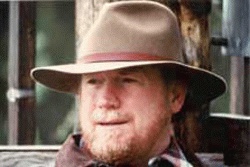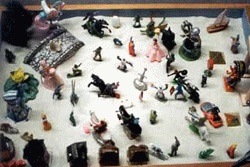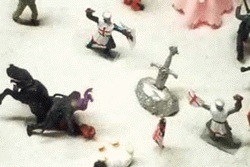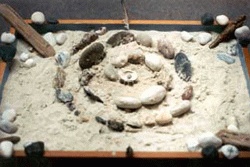|
The play therapy technique now called "sandplay" began as an experiment by the writer H.G. Wells who would sit on the floor for hours with his son imagining "worlds" made of miniature people, animals and objects. Therapists originally called it the "world technique" because the scenes constructed are indeed images of a world, a psychic world imagined by the client out of her conflicts, hopes and dreams.
The process is simple: Two people, a therapist and her client, sit beside a wooden tray painted light blue inside and filled half-way with sand, in a room with shelves bearing hundreds of miniature figures -- animals both real and imaginary, stones and feathers, sticks and marbles, beads, shells, all kinds of people (Indians, soldiers, knights, Wizard of Oz figures, ordinary boys and girls, etc.), houses, bridges, trees and plants, cars, boats, planes, and many others. The client is invited to put any items she wishes into the shallow tray, moving sand and objects until the scene feels right and she announces that she is through. The therapist photographs the sand world and, if she wishes, the client talks about the scene she has just created.
 |
| Al Collins, Ph.D. |
 |
Either then or later, the therapist may comment on the symbolism, or maybe respond on the level of the sandplay by suggesting another image, or asking how it would feel if an object were moved to another spot in the tray. Mostly, however, the therapist just looks on, her role that of a witness and accepting "container" of the process. She is in a way the "reader" of the client's sandplay narrative. There is a word in Sanskrit for the ideal audience for a work of art: sa-hrdaya, meaning one whose "heart" (hrd) is "one with" (sa-) the unfolding work as it is performed or recited. The sandplay therapist must be such an audience.
Sandplay grew mostly within the Jungian world, the psychological tradition following the Swiss psychiatrist C. G. Jung. It is a way of getting beneath the level of the conscious personality, of encouraging the unconscious mind, what Jungians call the Self, to work creatively with the psychological conflicts and unresolved needs of the person. Language can be used in this way, of course -- in journaling, poetry, fantasy, and other practices. There are also other visual and motoric ways of expressing and working through one's deep issues -- art therapy, other kinds of play therapy, psychodrama, and even Yoga are well known means of moving the psyche forward.
 |
| Elaine Molchanov, LCSW, IAAP |
 |
Sandplay is in some ways easier to begin than any of these, and perhaps for this reason is for many people a faster route to psychic transformation. The images used in sandplay are ready to hand, they do not have to be created by the client each time they are used. Further, because the images are carefully selected by the therapist, who has gone through her own personal analysis and sandplay experience, they are appropriate to express most of the issues the client's psyche might want to work with. The size of the tray -- just the dimensions the eye can easily survey from an arm's length away -- is conducive to containment, a sense of comfortable boundaries and safety. There is a feeling that this magical world coming to life in the sand is under control, is not in danger of exploding from the psychic dynamite that motivates its construction (though in young children such explosions do occasionally occur, and sand erupts over the side of the tray and onto the floor).
The experience of sandplay is intensely creative. One feels like a god, bringing world after world into being. Or rather, bringing one world to being in stages, for the trays constructed in successive sessions almost always express a process of development, transformation of themes, a moving forward of stories told without words. When the process moves towards completion, after a few or many hours of working in the sand, both client and therapist began to feel the sense of growing wholeness. At this point, the therapist may bring out the series of photographs she has made of the sand worlds, place them in sequence on a table and discuss the movement with the client. It is at this moment that sandplay most resembles verbal forms of narrative healing, as the story that enacted itself in the sand is retold in words. But never completely. However lucid and convincing the recapitulation may be, both client and therapist know that there is more in the images of the sandplay itself than can ever be said about them. In this respect sandplay resembles dream interpretation, for like the dream -- as Bottom said in "A Midsummer Night's Dream" -- sandplay is "bottomless." A world built on sand, it can never be fixed or cemented in place by the conscious ego and its instrumental language. Yet the verbal narrative does serve to bridge the abyss between the imaginary kingdom of sandplay and the existential life of the player. Constructed jointly between the client and therapist, the verbal anamnesis becomes a trail back to the nonverbal insights of the sand.
Sandplay Cases: A Child and an Adult
 |
| Sandplay scene by a seven-year-old. |
 |
This sandplay scene by a seven-year-old boy presents a psychological challenge typical for young children: the search for personal power in the midst of a world that feels highly dangerous and insecure. This boy fills the tray with female and male characters, both sexes represented in various benign and threatening guises. A good and a bad witch are present, and a queen and a ghost. There are a number of superhero characters, a magician, many knights, a dragon, two soldiers shooting one another at point-blank range, etc., etc. The Sword in the Stone stands at the center of the tray, beside a flag, a dead polar bear, and a knight who has fallen to the ground. Most of the figures are oriented towards the sword, suggesting that it is the source and aim of the action.
Viewing the center of the tray more closely, we see that there are two swordless knights on either side of the Sword. Are they seeking a sword they lack? Must they fight one another for it, as in the Arthurian tales? Over the next few months it became clear that this was indeed the case for this boy. With time his sandplay gradually moved toward a more assured possession of personal power, and his behavior towards his hated older brother improved.
 |
| Sandplay Tray Center |
 |
The sandplay of children naturally tends to center on developmental issues typical of their age: conflicts over attachment to parents vs. achievement of autonomy, love vs. hate, greed vs. self-control, and others. Adults come to sandplay with some of these same issues, but also new ones: sexual love vs. individual freedom, personal fulfillment vs. the need to make a living, depression vs. hope, etc. Very often sandplay attracts adults concerned with questions of personal meaning, the value of life, the quest for deeper significance. This tray represents one such, a woman in her late thirties.
The tray is oriented toward the four directions, with pieces of driftwood in two corners and mummies in the other two. Rocks form patterns of black and white beside the corner markers, and in the middle is a spiral of stones leading to a shell at the very center, in which lies the indistinct image of an infant.
Like the tray of the seven-year-old, this tray is oriented around a center. While not always the case, the focus on a center (marked by a flagpole, a tree, a bridge, etc., etc.) is quite common. Here, the center is a shell open to reveal content suggesting new life. A center often implies a way to reach it, as in a labyrinth or -- as here -- a spiral.
 |
| Very often sandplay attracts adults concerned with questions of personal meaning, the value of life, the quest for deeper significance. |
 |
The rigidly structured square world on the outside, reinforced by the mummies imprisoned within their stone carapaces, contrasts with the round open shell in the center, and the smoothly curving spiral pathway that leads to it. This is clearly an image of personal growth, projected into the sand in a vision for the future, a hope and plan for renewal. This hope was in fact realized in an ongoing sandplay process of several months.
|
 |
|




